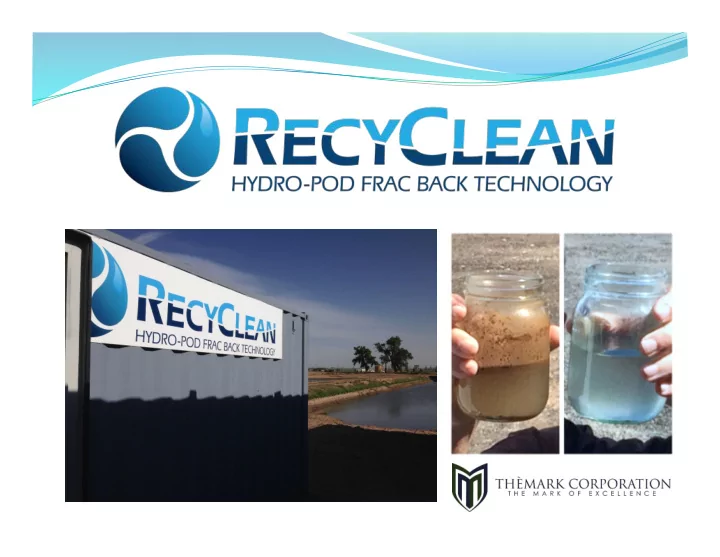

What is Frac Flowback Water? Why Treat it? Water that is returned back to the surface after hydraulic fracturing has occurred. The volume is usually 20-40% of the total volume used when Fracturing, but can be as high as 70%. The water contains oil, hydrocarbons, proppant sand, guar gum or polyacrylamide, bacteria, chemical cross-linkers, enzymes, and induced or naturally occurring mineral compounds. Removal of these contaminates allows the water that is normally disposed of as an oilfield waste to be recycled and used as an alternative to fresh water make-up for the next hydraulic frac. NO ENVIRONMENTAL LIABILITY – COMPLETE REUSE OF WATER!
What do you need to remove?
What is the Hydro-Pod™? A unique combination of technologies in a proprietary sequence to treat frac flowback water and production water. The most cost effective and efficient system on the market. 4000-4500 barrels per day per unit.
What is a Hydro-Pod™? The inside of a retrofitted Gen 2 unit.
Hydro-Pod™ Treatment Process
Step 1 – Ozone Loop The first step is to oxidize the flow back water that contains the oil, hydrocarbons, guar gum or polyacrylamide, bacteria, chemical cross- linkers, enzymes, and induced or naturally occurring mineral compounds with the ozone – O 3 . Why ozone? • It is the most powerful and safest oxidizer that exists • It can be made on site • It has a very short half-life and is gone in approx. 20 minutes • Very cost effective • Many years of effective use in a wide variety of industries NO ENVIRONMENTAL LIABILITY – COMPLETE REUSE OF WATER
The Ozone Generator
Step 2 – Electro CoagulaIon All of the contaminates are agglomerated into large particles (size >22 µ m) by the specific application of electrical current passing through a series of proprietary metal plates. We have an industry tested set of voltage application parameters including: voltage magnitude, time, type of current and polarity. The specific combination of these parameters has demonstrated success at treating frac flowback and produced water at an optimal rate. The EC columns are run in series and each unit has a capacity of 650 m 3 /d (150 GPM) Hydro-Pods™ may be run in parallel to obtain the desired daily treatment rate. Runs off 220v, 2-phase circuit.
The Electro CoagulaIon Columns
Step 3 – pH adjustment and polymer addiIon pH is adjusted as necessary to optimize system performance. The addition of a proprietary polymer enhances the EC process by allowing more rapid settling, especially at higher flow rates. Post-treatment, TSS is removed using a conventional industry process (clarifier, centrifuge, filter cartridge, etc.) to extract the clear water for reuse. Tests show that solid wastes (precipitate and floc) that are removed to be non-toxic and suitable for normal sanitary landfill. The system reduces salinity by 30-40%.
The unit PC is controlled and has cell or satellite uplink capability
Typical Layout for the unit Hydro-Pod™ Treatment Process
Oil & Gas Awards: 2015 Water Management Company of the Year
Water Management Company of the year 2015-Oil & Gas Awards Hydro-Pod™ Treatment Process
CASE STUDY – FLOWBACK WATER RecyClean conducted a Hydro-Pod™ lab study on frac flowback water for a client at their ponds north of Fort St. John, BC. The water was tested and shown to have a reduced ability to form scaling compounds that are detrimental to the effectiveness of the frac fluid, such as CaCO 3 and SrSO 4 . COMPONENT UNITS BEFORE AFTER % REMOVAL Fe (Iron) mg/liter 30.5 2.2 93% Ba (Barium) mg/liter 160 25 84% Ca (Calcium) mg/liter 4,500 2,500 44% CaCO 3 (Hardness) mg/liter 12,500 7,500 40% B (Boron) mg/liter 12.5 3.5 72% SO 4 2- (Sulfates) mg/liter 19.7 3.9 80% Cl - (Chlorides) mg/liter 71,500 52,500 27% Oil & Grease mg/liter 4 0.5 88%
CASE STUDY – PRODUCED WATER RecyClean conducted a Hydro-Pod™ field study on produced water for a client from Lauredo. The challenge was to treat produced water that contained a heavy oil emulsion for reuse on the client’s site. COMPONENT UNITS BEFORE AFTER % REMOVAL Fe (Iron) mg/liter 5.85 0.50 92% Ba (Barium) mg/liter 685 210 69% Ca (Calcium) mg/liter 865 780 10% CaCO 3 (Hardness) mg/liter 4750 1,800 62% B (Boron) mg/liter 850 250 71% SO 4 2- (Sulfates) mg/liter 1,260 35 97% Cl - (Chlorides) mg/liter 74,600 63,200 15% Copper mg/liter 1.4 0.05 96% pH n/a 6.5 8.5 n/a
Effect of Treatment on Actual Flowback Untreated 15 m O 3 30 m O 3 post-EC polymer + pH
Oilfield wastewater is turned into a reusable resource!
Recommend
More recommend